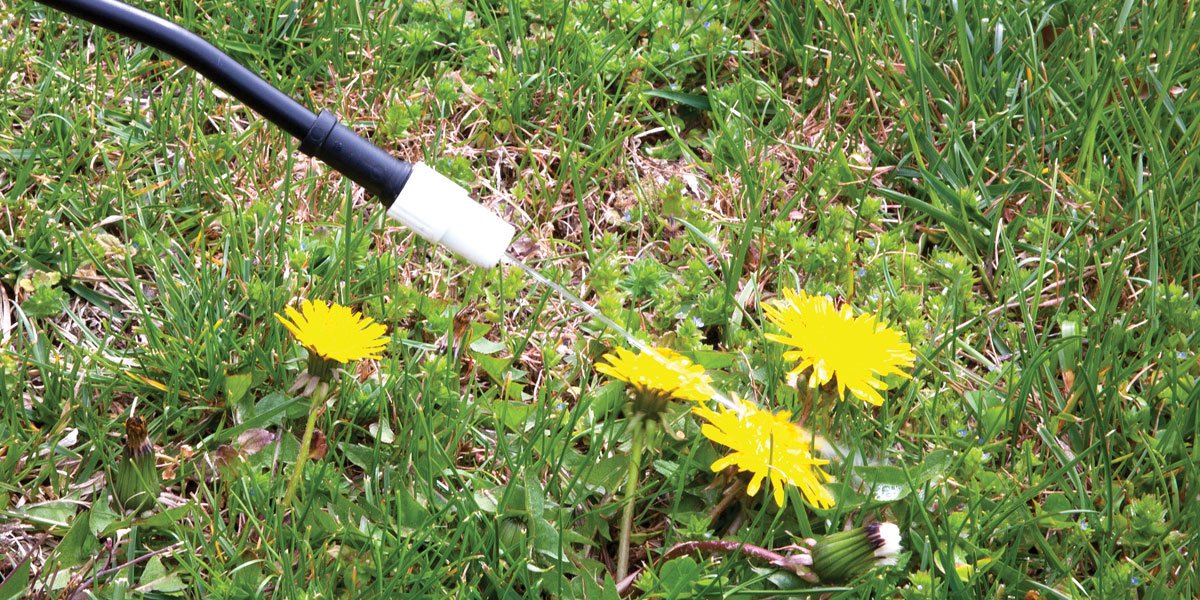By Dr Brett Morris, Technical Manager at Amgrow
The pesticide community have been left shaking their heads following a series of decisions which commenced in August last year when two separate Californian juries, in the United States (US), awarded an initial US$289 to a man who claimed that Roundup caused his cancer, followed by US$2 billion to a couple who claimed the same effects. Thousands of cases now have been lodged globally with the movement against glyphosate only growing.
Online activists have prompted many regulators globally to issue a number of statements regarding the issue, in response to lawyers relying on the World Health Organisation’s International Agency for Research on Cancer (IARC) who reclassified glyphosate as a ‘probable carcinogenic’ in 2015. Others on this list include being a hairdresser, undertaking shift work, drinking very hot beverages, eating red meat (including bacon) and drinking coffee. In California last year, a judge ruled that because coffee contains acrylamide (also on the list) – all coffee in the state should be labelled with a cancer risk statement. Regulators earlier this year moved relatively swiftly to remove the coffee statement stating that the “overall effect of coffee consumption is not associated with any significant cancer risk”.
But regulators have struggled to be heard amongst the online noise surrounding glyphosate despite all coming to the same conclusion. Regulators in the European Union, Australia, Japan, Canada and even the US Environmental Protection Agency (EPA) all conclude that glyphosate is not a risk to humans at the levels to which they are exposed when following label directions.
I truly believe being authentic, collaborative, maintaining open communication and having the attitude of “tell me what I can do, not what I can’t” is vital in making this role work.
In response to the IARC reclassification in 2015, the US EPA reviewed 167 studies and provided its findings. IARC reviewed fewer than half and also included studies on non-mammalian species such as worms and reptiles, therefore the data presented was not directly appropriate to human usage. A study published in May 2018 in the US Journal of the National Cancer Institute examined just under 45,000 licensed pesticide applicators who regularly used glyphosate and found no association with the use of glyphosate and cancer.
However, when Bayer’s lawyers moved to have the US EPA’s review findings that glyphosate is noncarcinogenic and poses no risk to public health when applied as directed during the trial, the judge replied, “what’s the relevance?” before dismissing the request.
The relevance as we find ourselves now is that science and facts don’t seem to matter thanks to the continuing assault by online activists. The scare campaign is now determining decisions made by those in public office with a number of councils and other decision makers placing glyphosate either under review or ceasing usage all together. Many no doubt would be concerned of future litigation whether they agree or disagree on the topic privately.
Regulators in the European Union, Australia, Japan, Canada and even the US Environmental Protection Agency (EPA) all conclude that glyphosate is not a risk to humans at the levels to which they are exposed when following label directions.
Australia has one of the most robust regulation systems when it comes to determining the approval and use of any pesticide in the country . And, in recent years, no other chemical has been scrutinised as heavily as glyphosate. But what are the alternatives?
Glufosinate would come to mind initially as an alternative but as we know is not systemic. Is it safer? A quick check on the Pesticide Properties Database shows LD50 (acute oral) values for glyphosate at >2000milligrams per kilogram (mg/kg) and glufosinate at 1625mg/kg. These figures are not to be confused with the lower the better, rather the opposite. One requires less glufosinate than glyphosate to reach the lethal dose in an acute oral sense.
Given the relatively cheap nature of glyphosate in the agricultural sector any ceasing of usage and switch to alternate products will likely result in increased costs. Whether it be councils, farmers or any other commercial user of glyphosate, it is likely those increase in costs will be passed on to the rate payer or end consumer. It would be doubtful anyway that any analysis has been conducted on this at this stage.
It has meant however that many companies have been undertaking work to find alternatives and we are no exception. More organic options will emerge over the coming time plus combination herbicides to provide both contact and systemic effects.
We all hope that a time will not come when glyphosate is banned altogether. Based on the scientific facts presented by global regulators it is likely not to come at any time soon. But we need our regulators heard and our science considered. Unfortunately, with social media today you are not allowed an alternate opinion to the populist approach unless you are prepared for the barrage from the keyboard warriors. I for one though will rely on what our regulator recommends and not what the IARC suggests. It won’t stop me from eating bacon either!
About Dr Brett Morris

Dr Brett Morris has been involved in the international turfgrass, amenity horticulture and agriculture industries now for over 28 years. He has completed a PhD in breeding new commercial lines of Kikuyu grass. A number of these hybrids are now in further investigation by local and state authorities within Australia in diverse environmental conditions such as salt affected sites and uses in other sporting and agriculture environments. Today, Dr Morris oversees the technical arm of Amgrow including product development, regulatory activities, group import permit management, consulting, training, product support and agronomy services.

Glyphosate – what you can tell the consumer
With the media, both in Australia and overseas, fuelling the Glyphosate debate it is important that the facts are not marred. Social media is also playing a role in the discussion and has only helped to confuse the simple layperson. Below is insightful Q&A material, produced by CropLife Australia who represent the plant science industry, for TurfBreed growers to use as a resource for their customers in the Glyphosate debate.
Q Why did IARC classify glyphosate as a probable carcinogen?
The International Agency for Research on Cancer (IARC) is not a regulatory agency and does not undertake any research of its own.
It plays a role in advising regulatory bodies on potential hazards. This allows the relevant regulatory agencies to assess if there are any associated risks and manage them appropriately.
Substances such as aloe vera, pickled vegetables and coconut oil are all on the IARC lists of possible or probable carcinogens.
In 2015 IARC placed glyphosate on its probable carcinogen list from a pure hazard perspective. While that sounds alarming at first, it simply means glyphosate is in the same category as shift work or consuming red meat or beverages above 65°C.
The world’s leading independent scientific regulators comprehensively reviewed the IARC report and reaffirmed that products containing glyphosate pose no risk of cancer.
“Fake news serves us poorly. As Academy of Science Fellow Dr TJ Higgins once said ‘red herrings are in plentiful supply but they will not feed nine or10 billion people’. GM (genetic modification) and glyphosate, however, just might.”
PROFESSOR EMERITUS JIM PRATLEY,
CHARLES STURT UNIVERSITY
Q What is glyphosate?
Glyphosate is the most widely used herbicide in the world. It is independently recognised as one of the safest and most effective herbicides ever developed. There are many products containing glyphosate registered for use in Australia, from home gardens through to commercial farms.
“EPA continues to find that there are no risks to public health when glyphosate is used in accordance with its current label and that glyphosate is not a carcinogen.”
US ENVIRONMENTAL PROTECTION AGENCY (EPA)
Q Should I be concerned about the toxicity of glyphosate?
Glyphosate is less toxic than table salt. Independent scientific analysis confirms glyphosate‑based products are safe. More than 800 scientific studies and independent safety assessments by the world’s most respected regulators support the fact that use of glyphosate‑ based products does not cause cancer.
“Glyphosate does not pose a cancer risk to humans when used in accordance with the label instructions.”
AUSTRALIAN PESTICIDES AND VETERINARY MEDICINES AUTHORITY (APVMA)
Q Haven’t US court cases proven a link between glyphosate and cancer?
No, the recent California civil litigation cases have been decided by juries—not on the basis of scientific assessment.
The US Agricultural Health Study has been running since 1993 looking specifically at the risk between glyphosate exposure and non‑Hodgkin lymphoma. In that time investigators from the National Cancer
Institute, the National Institute of Environmental Health Sciences, the Environmental Protection Agency and
the National Institute for Occupational Safety and Health have comprehensively analysed data from over 89,000 farmers and their spouses. They have found no association between glyphosate and non‑Hodgkin lymphoma— regardless of the exposure level.
“The evidence for carcinogenicity of a good curry or a cup of coffee and a ham sandwich is much stronger than that for glyphosate.”
ADJUNCT PROFESSOR ANDREW BARTHOLOMAEUS, UNIVERSITY OF CANBERRA
Q How can I use glyphosate safely?
All chemical products, including home cleaning products used daily, have instructions for safe and correct use on the label. To ensure the safe use of chemical products, including glyphosate‑based herbicides, always read the label and use as directed.
Q How can I be sure glyphosate is safe?
Australia’s agricultural chemical industry is regulated to the same extent as human pharmaceuticals.
Before any agricultural chemical product can be sold or manufactured in Australia, it goes through rigorous scientific assessment by the Australian Pesticides and Veterinary Medicines Authority (APVMA). They assess the safety and expected use of the product. In 2016 the APVMA examined glyphosate, following IARC’s classification, and found there were no grounds for its approved uses to be reconsidered.
Every independent, science‑based regulatory agency globally (including; Germany, New Zealand, Canada, the US, Japan and the European Union) has comprehensively evaluated glyphosate and found it safe to use.
“Residues in food are so low for all chemicals and glyphosate too, that there is no cancer risk.”
PROFESSOR BERNARD STEWART, SCIENTIFIC ADVISOR, CANCER COUNCIL AUSTRALIA
Q Isn’t glyphosate bad for the environment?
Glyphosate, like all crop protection and weed management products, plays a critical role in environmentally sustainable land management practices.
The application of glyphosate eradicates pests without having to disturb the soil and disrupt the weed’s roots via tillage. It is scientifically proven that conservation tillage, enabled by glyphosate, can reduce soil erosion by up to 90 per cent, significantly improve water retention and increase or maintain carbon storage.
Q What if we didn’t have glyphosate?
Glyphosate is an essential tool for Australian farmers, environmental land managers and councils to be productive in an environment that is under constant threat of weeds.
Over two thirds of the food on your plate and the beer or wine in your glass exists because our farmers have access to safe, modern crop protection products. Without crop protection, up to 80 per cent of the globe’s crops could be lost to weeds, pests and diseases.
Continued judicious use of agricultural chemicals ensures Australian farmers, environmental land managers and councils can effectively control pests, weeds and diseases. In turn, the community enjoys safe, abundant, disease‑free and affordable food, pristine natural environments and parks free from invasive weeds, and safe roadsides with visible signage.

